Recent Commercial Posts
Safeguarding Your Business With Our Help | SERVPRO of Downtown Las Vegas
2/21/2024 (Permalink)
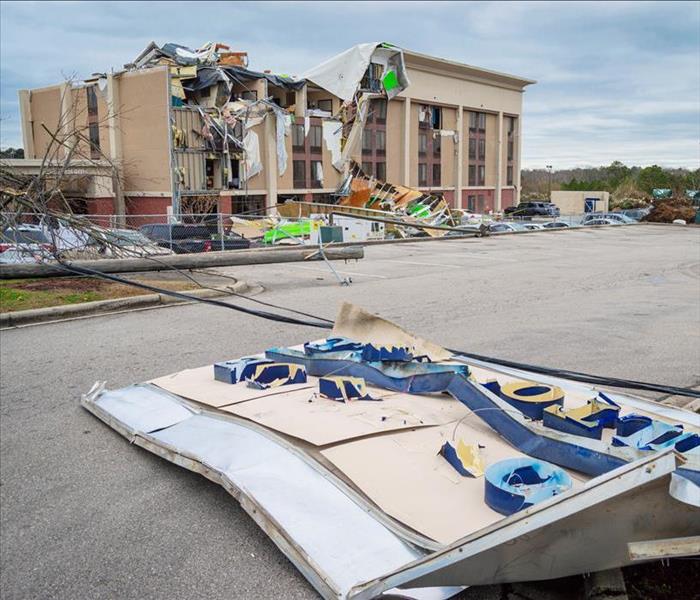 When disaster strikes your building it can feel extremely overwhelming. That's why SERVPRO of Downtown Las Vegas is here for the rescue. Call us now!
When disaster strikes your building it can feel extremely overwhelming. That's why SERVPRO of Downtown Las Vegas is here for the rescue. Call us now!
Our downtown area is world-renowned for all of the arts, entertainment, fun and delicious food, and we have our wonderful businesses to thank for that.
Every business from the very end of the Strip to Fremont Street offers an important service and is a vital part of our community. That’s why we want to return the favor and help ensure your business is as successful as possible.
We proudly offer our restoration and cleaning services to all of the businesses in the downtown area. We explain more about each of our services below, so check it out to learn more about how we can help you.
Large Restoration Projects
Disaster can strike your business at any time and can have a huge impact on a large number of people. A fire on one level of your hotel could displace thousands of people, a kitchen fire at the back of your restaurant could turn dozens of hungry people out on the street or even a simple busted water line could impact your ability to serve people in a timely manner.
In any case, a fast recovery and restoration is crucial to ensure the safety and comfort of your guests. Our large-loss recovery team is up to the task!
We understand the time-sensitive nature of these situations, and we will get right to work cleaning, restoring and sanitizing your space. We have helped hotels, restaurants, casinos, local gift shops and entertainment venues, so we are well-versed in all of the different businesses in our community.
Keeping It Clean
When you are in the public service industry, you know that presentation matters. The public is constantly flowing in and out of your building and sometimes you only get one shot at a good first impression. This is why having a clean space is crucial! You don’t want your patrons to be focused on your dirty carpets or dusty vents because that takes away from the experience.
Let us handle these cleaning duties for you so you can focus on other aspects of your business. We are trained to handle everything from deep carpet cleanings to odor removal and everything in between.
Our goal is to help keep your business clean and sparkling so your guests will want to come back to your place time and time again.
Our team is always here for you no matter what kind of restoration and cleaning assistance you may need. Give us a call today
How To Use a Fire Extinguisher?
10/5/2022 (Permalink)
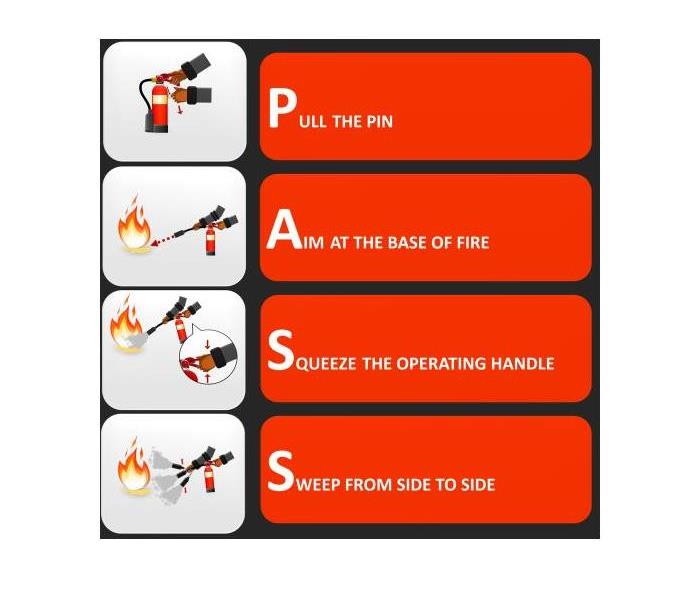 PASS fire method
PASS fire method
Use of a Fire Extinguisher
A fire extinguisher is an important tool that every household or business should have. With the right kind of training and education, you can use it to fight fires and prevent them from spreading. A fire extinguisher has three main components: the cylinder (which holds the agent that puts out the fire), the handle (or trigger), and a nozzle for directing the agent at the flames. Here's how each part works.
1. Assess the situation: is it safe?
Before you can use a fire extinguisher, you need to make sure it's safe for you and others around you. This includes making sure that:
- The fire is out of control. You should never try to put out a potentially dangerous fire unless there's absolutely no other option—if the situation requires immediate action, then get out of there! If you think it's safe enough to use an extinguisher, proceed as follows:
2. Pull the pin and aim the extinguisher
- Pull the pin and aim the extinguisher
- Pull the pin to release it from its mount. Aim at the base of the fire and squeeze the lever fully, aiming towards where you want to send foam or water. Sweep back and forth over the affected area
3. Squeeze the lever to release the extinguishing agent
Now that you have aimed and released the extinguishing agent, it is time to make sure that it does its job. To do this, use a continuous sweeping motion with the hose until you see no more flames or glowing embers. Make sure to aim at the base of any fires so that they are fully covered in foam.
4. Sweep the nozzle from side to side
Sweeping the nozzle of a fire extinguisher back and forth will help you cover an area with foam, helping to put out flames. Never aim the nozzle at a person, pet, or object as it could damage them or cause injury. Be careful not to get any of the agent as yourself as it can be harmful to your skin.
A fire extinguisher can help you fight fires, but only if you know how to use one properly.
In case of an emergency, the right fire extinguisher can mean the difference between life and death. But always remember, your safety and the safety of those around is always priority number one. In the case of a fire, here’s what to do:
- Call 911 immediately. This is the most important step. Take note of how many people are in the room and if anyone needs medical help.
- Make sure nobody else is going to put themselves at risk by trying to fight the fire on their own.
- The next thing you need to do is make sure that everyone gets out safely, especially those who might be injured or have mobility issues like seniors or children who aren't able to escape by themselves easily (or at all).
As you can see, it’s not that difficult to use a fire extinguisher. The most important thing is to take the time to assess the situation and make sure that it’s safe for you to approach the fire before you do anything else. Next, pull out the pin and aim your extinguisher at the flames. Then squeeze the lever so that it sprays out its contents onto any nearby combustibles. Finally, sweep across any areas where embers may remain after being extinguished by this method with another person helping if possible, so as not get burned again while doing so (especially important if using water).
What You Should Know About Emergency Ready Profiles
6/20/2022 (Permalink)
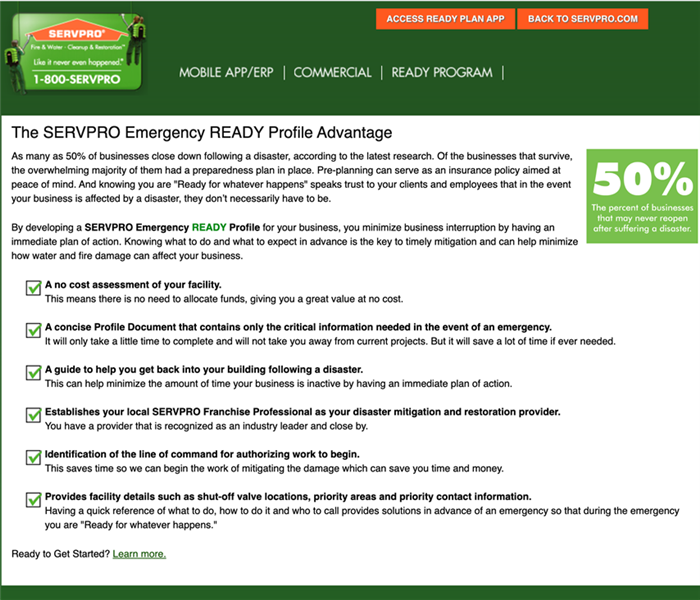 An emergency ready profile (ERP) is a plan of action that details your facility’s key points.
An emergency ready profile (ERP) is a plan of action that details your facility’s key points.
Emergency Ready Profiles
Many businesses do not survive a disaster. Those that do survive most likely have a disaster preparedness plan in place. A key component of any disaster preparedness plan is the emergency profile. This profile contains crucial information that business owners and disaster mitigation experts can use to guide a business through a disaster and help ensure a smooth recovery.
1. What Is an Emergency Profile?
An emergency ready profile (ERP) is a plan of action that details your facility’s key points, such as water main and shut-off valve locations, power sources, priority areas, vulnerable areas, and contact information. It also identifies the chain of command and who authorizes cleanup and restoration work. Pertinent photos and diagrams are commonly included in the profile.
2. What Are the Advantages of Having an ERP?
Having an emergency profile speeds up the recovery process after a disaster. With the profile, the disaster mitigation team knows what has to be done and how it will be done and can begin work right away. The profile also instills trust and confidence among your clients, customers, suppliers, and employees if they know you are prepared and not likely to be shut down by a disaster.
3. What Is the Best Tool For Creating and Sharing Your Profile?
The ERP app, available for both ISO and Android devices, allows you to create, store, and share your emergency profile across platforms. Users can easily input and update information in the app, and that information can be instantly shared between business owners and members of the disaster mitigation team.
Business owners in Downtown, NV, can contact SERVPRO to arrange for an assessment by disaster mitigation and restoration professional. These folks can walk you through the process and give you peace of mind knowing your business can weather any disaster.
3 Questions To Ask Your Commercial Mold Remediation Team
5/22/2022 (Permalink)
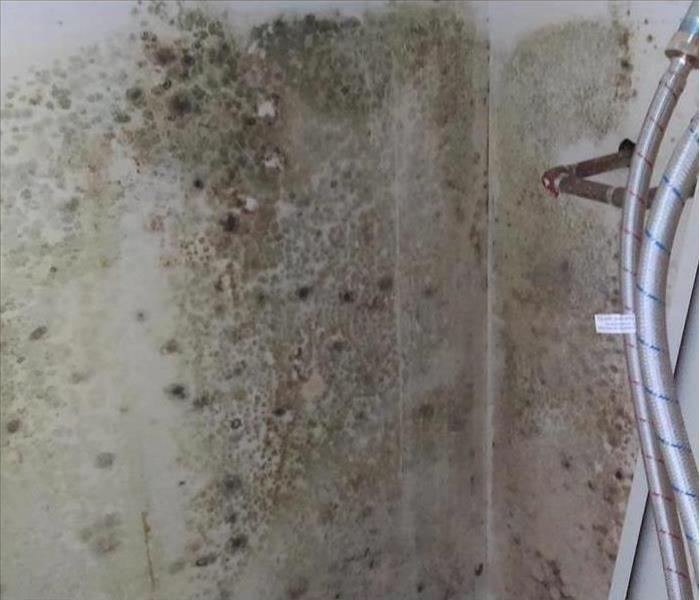 Mold damage in Fremont Street, NV.
Mold damage in Fremont Street, NV.
Commercial Mold Remediation
When mold invades your Fremont Street, NV, business, it can be difficult to know where to turn. Mold removal is not something you want to take lightly, especially when you have little to no experience in how to handle it. Calling in an experienced remediation and restoration team can give you peace of mind when it comes to ridding your commercial building of mold, and there are several questions you can ask about the process.
1. Do I Have Black Mold?
One of the most common types of fungi many business owners encounter is black mold, which can develop as quickly as 24 hours after a water event. This fungi gets its name from its dark green to black appearance and can appear on drywall and other building materials in affected, humid areas. Your remediation team can verify whether this is the type of mold that must be removed.
2. How Long Will Removal Take?
The timespan for mold removal may depend on a variety of factors, but the most important is usually the size of the mold growth and how far it has already spread. Depending on the severity of the invasion, it can take up to seven business days for the mold technicians to assess the situation, provide you with solutions and then completely remove the mold in a manner that is safe for everyone in the building.
3. Will I Have To Evacuate the Building?
Your mold remediation technicians will probably advise you about which safety measures to take, which may include sending your employees home or moving them to a safe space in which to work while the process takes place. Consider allowing your employees to work from home until it is safe for them to return so no stoppage is necessary.
Mold removal at your Fremont Street, NV, business does not have to disrupt the normal operation of your company when handled by professionals. Asking a few important questions can offer you peace of mind before, during and after the process.
4 Tips To Avoid Mold in Your Restaurant
4/8/2022 (Permalink)
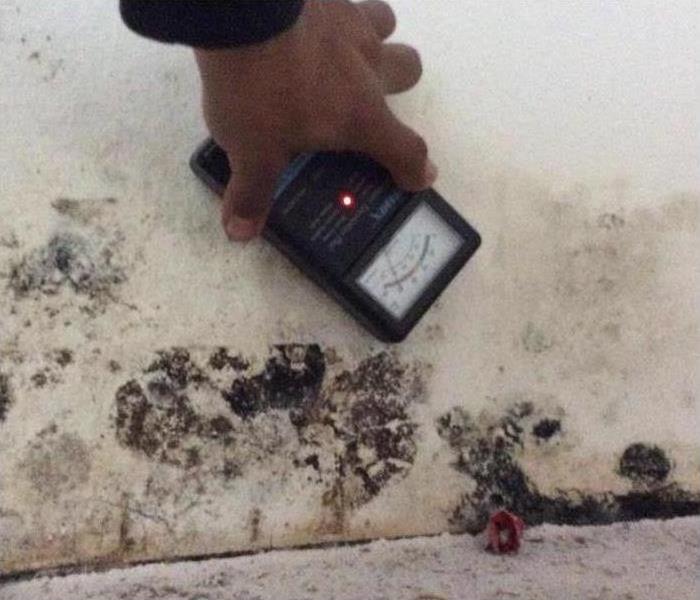 It's important to keep your humidity levels in check.
It's important to keep your humidity levels in check.
Avoid Mold In Your Restaurant
Running a restaurant is ultimately all about the customer experience. Mold growth in your kitchen is one of the last things you’d want your customers to associate with your restaurant, yet it’s a surprisingly common issue in the restaurant industry. Follow these tips to avoid a mold outbreak in your Medical District, NV, restaurant.
1. Be Aware of Mold-Prone Areas
It’s no secret that mold needs moisture to grow and multiply, and you probably already know that moisture-prone spaces attract mold spores. A restaurant kitchen is, in general, an environment with notoriously high humidity levels. However, some areas of your kitchen are likely more attractive to mold than others. Areas to watch closely include any place that tends to be dark, warm, and prone to condensation buildup, such as behind refrigerators and coolers and under sinks.
2. Take Care of Your Ventilation System
A functioning, properly maintained ventilation system is critical to preventing mold growth in a restaurant kitchen. Your ventilation system circulates air through your kitchen and is your primary means to minimize moisture in the air and decrease humidity levels. Your ventilation system is also responsible for either introducing or preventing dust, dirt, and contaminants, which can encourage mold, from entering your kitchen. Be sure to keep up a regular maintenance schedule.
3. Monitor Humidity Levels
High humidity is a key factor in mold production, so it’s important to keep your humidity levels in check. Hygrometers, which measure humidity, are inexpensive and widely available. Aim for a reading of 30-50%.
4. Keep It Clean
Keeping your restaurant kitchen as clean as possible is the best way to prevent a mold outbreak. Clean high-traffic and high-moisture areas regularly, and don’t forget corners and hidden spaces where mold flourishes. Keep an eye out for any signs of water damage. If you suspect damage, be sure that professional restoration efforts begin as soon as possible before mold begins to colonize.
No one likes to picture mold when they think about their favorite restaurant. These tips can help you avoid mold growth in your restaurant kitchen.
Sluice, Don’t Fail Me Now
2/5/2022 (Permalink)
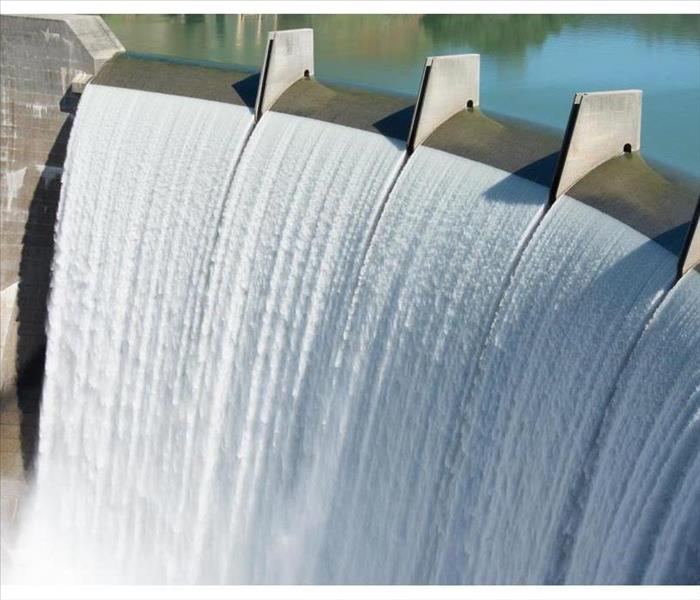 Dams are another barrier to prevent high water levels.
Dams are another barrier to prevent high water levels.
Four Types of Water Control Systems
When moving your business to an area that deals with high water levels, it is essential to understand how that city goes about flood prevention. While you can purchase flood insurance and make emergency response plans, you shouldn’t have to worry that your city isn’t doing its fair share to protect you. There are mainly four types of water control systems used by cities all over the world, and it pays to understand how they work.
1. Dikes
One of the most common tools used to prevent and even stop flooding is a dike. Made of earth and rock, dikes resemble natural structures. This type of barrier originated in the Netherlands where most of the population lives below sea level.
2. Dams
Another barrier used to prevent high water levels; a dam is typically constructed of steel and concrete. These large man-made objects are used to control water levels and also to distribute water for activities, like consumption, industrialization, irrigation and much more.
3. Sluices
A sluice is a pressure-activated gate that is used to prevent flooding by essentially using controlled flooding techniques. When water levels are low, the gate remains sealed, but when the pressure increases the gate opens, allowing water levels to fall.
4. Locks
Water locks are used more in the transportation industry but are also a means of controlling water levels. There are two gates connected by a channel. The water level is higher behind one gate than the other. When necessary, the high-level gate opens flooding the channel, this is followed by a similar action by the low-level gate.
Granted, knowing how your city responds to flooding is useful, but when a flood happens, you will need to rely more on your own protective measures. Ensuring that you have flood insurance and a response plan from a disaster restoration specialist in the Fremont Street, NV, area are likely your best options.
Operating in an area with high water levels can be nerve-wracking. That’s why, while it is important to know your cities preparation plans, it is more important to have plans of your own.
Fire Restoration Professionals: Why You Should Call a Professional for Your Remediation Needs
1/11/2022 (Permalink)
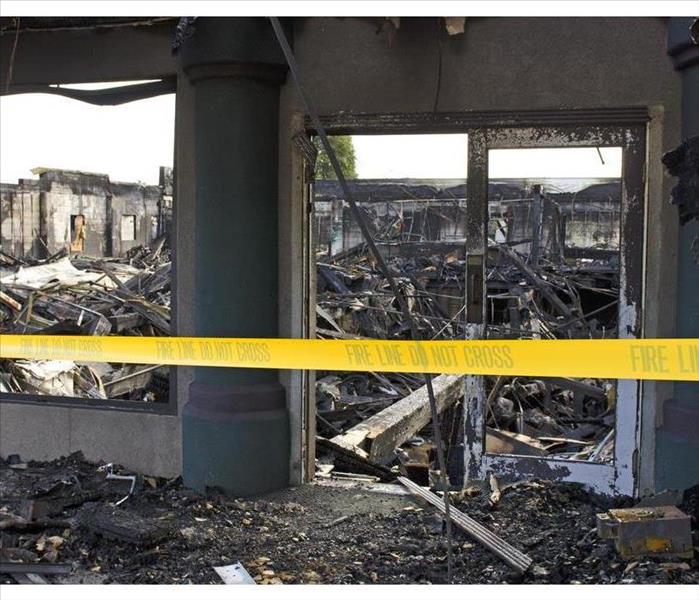 Commercial fire damage in Downtown, NV.
Commercial fire damage in Downtown, NV.
Fire Restoration Professionals
A commercial fire is often severely damaging for business owners, and the fire damage restoration process can be intimidating. Thankfully, you can enlist the help of a disaster restoration specialist in the Downtown, NV, area to take on the brunt of the work.
1. Availability
Most of these professional services offer 24 hour-a-day and seven-days-a-week availability, meaning that they are ready and willing to work whenever a disaster strikes your building. You can even call the company in the middle of the night during a holiday, and they can quickly be there to offer assistance in whatever way they can.
2. Assessment
Fire damage restoration experts will likely start by offering a free assessment of your property. They may walk the area, taking note of all structural damage and property loss, listening to your concerns, and offering an estimate of the work to be completed. Also, the individuals who provide the estimate will likely be the managers of your entire project.
3. Security
Beyond the initial assessment, most restoration companies offer tarping and board-up services to mitigate further loss and ensure the security of your facility. Some companies will even provide 24-hour surveillance, either in person or video. Whichever company you choose, make sure that the protection of your property is a priority because receiving your insurance coverage may depend on it.
4. Cleanup
While many of these companies advertise some expertise in water, fire and smoke cleanup, they may also be experts in several disciplines. Additionally, most companies can act as intermediaries between contractors, so you can rest assured that your business is cleaned, repaired and rebuilt with the least amount of stress as possible.
The fire damage restoration process can be grueling, but it doesn’t have to be your burden alone. Most restoration companies have excellent contractors in-house and have outstanding project managers as well. Reduce your stress and hire a skilled restoration team.
 When disaster strikes your building it can feel extremely overwhelming. That's why SERVPRO of Downtown Las Vegas is here for the rescue. Call us now!
When disaster strikes your building it can feel extremely overwhelming. That's why SERVPRO of Downtown Las Vegas is here for the rescue. Call us now!





 24/7 Emergency Service
24/7 Emergency Service





